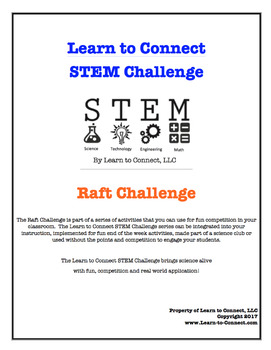Raft Challenge by Learn to Connect STEM
Learn to Connect
7 Followers
Grade Levels
4th - 9th, Homeschool
Subjects
Resource Type
Standards
CCSS4.MD.A.1
CCSS4.MD.A.2
CCSS4.OA.A.3
CCSS6.EE.A.2c
CCSS6.EE.B.7
Formats Included
- Zip
Pages
20 pages
Learn to Connect
7 Followers
Description
The Raft Challenge by L2C is part of a series of activities that you can use for fun competition in your classroom. The Learn to Connect STEM Challenge series can be integrated into your instruction, implemented for fun end of the week activities, made part of a science club or used without the points and competition to engage your students in curriculum.
In this STEM activity the students will build background on rafts by examining density and buoyancy definitions, calculations and participating in an investigation that calculates the density of materials available to build the classroom rafts. The class will then break into teams to construct a raft with the goal to hold the largest mass. The rafts will be evaluated by placing weights on them in the classroom. You can make this aspect of the lesson competitive with the STEM Challenge Points or just allow the kids to enjoy the engagement and fun. Finally, students will be given a word problem to apply what they have learned to being stranded on an island.
This activity is three hours of engagement and problem solving that can be done all in one day or broken into 3 to 4 classes. The materials that are required for this lesson are simple. All you need is Ping-Pong balls, tape, Popsicle sticks, rubber bands, Styrofoam and water bottles. This activity includes a 7 page lesson aligned to the National Next Generation Science Standards along with pictures to make the activity even more clear. It also includes a 4 page Student Investigation Packet that will guide students thought the activity. Finally there are two versions of a Power Point so you can guide the whole group. One power point can be edited to meet your classroom's needs, while the other is in pdf format.
The Learn to Connect STEM Challenge brings science alive with fun, competition and real world application!
In this STEM activity the students will build background on rafts by examining density and buoyancy definitions, calculations and participating in an investigation that calculates the density of materials available to build the classroom rafts. The class will then break into teams to construct a raft with the goal to hold the largest mass. The rafts will be evaluated by placing weights on them in the classroom. You can make this aspect of the lesson competitive with the STEM Challenge Points or just allow the kids to enjoy the engagement and fun. Finally, students will be given a word problem to apply what they have learned to being stranded on an island.
This activity is three hours of engagement and problem solving that can be done all in one day or broken into 3 to 4 classes. The materials that are required for this lesson are simple. All you need is Ping-Pong balls, tape, Popsicle sticks, rubber bands, Styrofoam and water bottles. This activity includes a 7 page lesson aligned to the National Next Generation Science Standards along with pictures to make the activity even more clear. It also includes a 4 page Student Investigation Packet that will guide students thought the activity. Finally there are two versions of a Power Point so you can guide the whole group. One power point can be edited to meet your classroom's needs, while the other is in pdf format.
The Learn to Connect STEM Challenge brings science alive with fun, competition and real world application!
Total Pages
20 pages
Answer Key
N/A
Teaching Duration
3 hours
Report this resource to TPT
Reported resources will be reviewed by our team. Report this resource to let us know if this resource violates TPT’s content guidelines.
Standards
to see state-specific standards (only available in the US).
CCSS4.MD.A.1
Know relative sizes of measurement units within one system of units including km, m, cm; kg, g; lb, oz.; l, ml; hr, min, sec. Within a single system of measurement, express measurements in a larger unit in terms of a smaller unit. Record measurement equivalents in a two-column table. For example, know that 1 ft is 12 times as long as 1 in. Express the length of a 4 ft snake as 48 in. Generate a conversion table for feet and inches listing the number pairs (1, 12), (2, 24), (3, 36),...
CCSS4.MD.A.2
Use the four operations to solve word problems involving distances, intervals of time, liquid volumes, masses of objects, and money, including problems involving simple fractions or decimals, and problems that require expressing measurements given in a larger unit in terms of a smaller unit. Represent measurement quantities using diagrams such as number line diagrams that feature a measurement scale.
CCSS4.OA.A.3
Solve multistep word problems posed with whole numbers and having whole-number answers using the four operations, including problems in which remainders must be interpreted. Represent these problems using equations with a letter standing for the unknown quantity. Assess the reasonableness of answers using mental computation and estimation strategies including rounding.
CCSS6.EE.A.2c
Evaluate expressions at specific values of their variables. Include expressions that arise from formulas used in real-world problems. Perform arithmetic operations, including those involving whole-number exponents, in the conventional order when there are no parentheses to specify a particular order (Order of Operations). For example, use the formulas V = s³ and A = 6 s² to find the volume and surface area of a cube with sides of length s = 1/2.
CCSS6.EE.B.7
Solve real-world and mathematical problems by writing and solving equations of the form 𝘹 + 𝘱 = 𝘲 and 𝘱𝘹 = 𝘲 for cases in which 𝘱, 𝘲 and 𝘹 are all nonnegative rational numbers.




